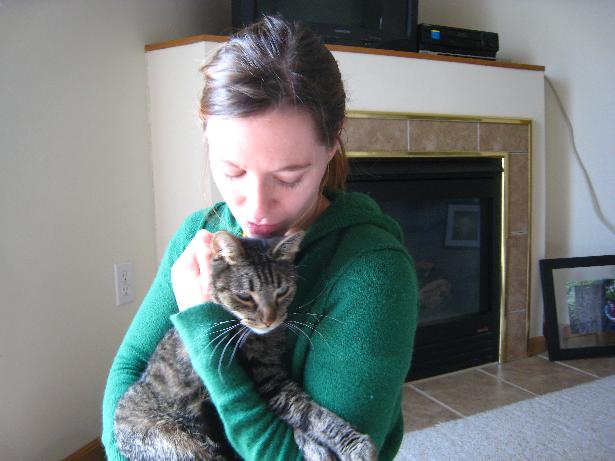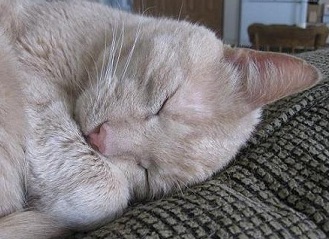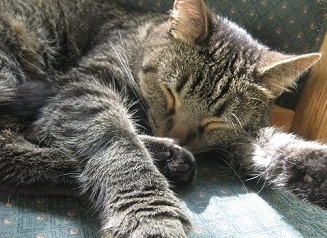My two cats have all their claws.
My 6-year-old couch is for the most part ruined because of the cats. Stuffing is showing. I keep the ends covered in blankets to hide the majority of the damage.
Our living room is very “classy.”
I really do not want to live like a college student for the rest of my life. I’m sorry, but I like having nice things. I don’t know if you’ve seen our apartment lately, but we could really, really stand a few upgrades.
But what will the cats do if we get a new couch?
They’ll do what cats do best. They’ll destroy it.
Update: We did get a new couch, and our cats did not destroy it. We used a very firm NO and squirted them with water when they touched it and followed a strict a no-cats-allowed-on-the couch rule. This has worked.
When it comes to scratching, cat owners have these options:

1. Put up with the property damage while attempting some kind of behavior modification (ha!)
2. Confine the cats when you can’t supervise
3. Purchase vinyl caps to glue over the cats’ nails (yes, I’m serious)
4. Declaw the cats
Obviously some people choose another option. They get rid of the cats.
Which option would you recommend?
Cat training
Most of us tolerate scratching and property damage while decorating our homes with scratching posts, pieces of cardboard and kitty jungle gyms.
I’ve been doing this for six years.
My cats scratch everything I give them and the furniture. And when given a choice, they will always choose to scratch the couch.
To be fair, I should probably purchase a few more scratching posts to entice Thing One and Thing Two. And I should provide several options for them. Some cats love to scratch strips of cardboard. Some like pieces of carpet. Some people even bring logs inside for the cats to scratch (after shaking off any insects and leaving the wood in the sun for a few days).
With a little catnip, I can get my cats interested in almost anything. I do owe it to them to offer additional scratching options.
Ignore the unwanted kitty behavior
My cats learned that if they scratch the couch in my presence they will get a reaction. Like children (and dogs!), sometimes any attention is good attention.
Scolding them is the biggest mistake I’ve made.
If either cat is frustrated or hungry, he will scratch the couch in my presence in order to get a reaction.
But I’ve also put a lot of energy into ignoring the unwanted behavior. This sort of works. But they still scratch when I’m not around.
I’ve also tried to distract them or get them interested in something else. This works as long as I’m in the room. When I’m not there to distract, they go for the couch.
Squirt the bastards with water – right in the face!
I’ve used plenty of “positive punishment” techniques like squirting them with water. Although this is very satisfying, they still scratch when I’m not around.
Trim your cats’ nails
I trim my cats’ nails a few times per month. That’s always fun, but it doesn’t stop them from scratching.
If you have other behavior modification tips, please share. Perhaps clicker training? More time interacting with your cat?
Kitty jail
Put the cats in another room when you are not home
This is my best solution for now.
I treat my cats like puppies. They lost their nighttime freedom a long time ago. When I am not able to supervise, they go into the laundry room where they have cat beds, their litter box and water. It’s not any more “cruel” to confine a cat than it is a dog. They are animals and they deal with it. My cats sleep a good 19 hours out of every 24, so they might as well serve some of that time in the laundry room.
I don’t feel at all guilty about confining them. Still, I know if given the choice, my cats would choose the freedom to roam around.
Nail caps for cats
These are called Soft Paws Nail Caps for cats, and they are hilarious! I can’t imagine they would work, but I would be willing to give it a shot. Soft Paws are vinyl nail caps that are glued to the cat’s nails. Has anyone tried these? I would love to hear your feedback. You can get them in all kinds of colors, and they are actually really cute. They look like the cat is wearing nail polish. I would definitely order them in pink and purple for my boys out of spite.
Like any tool, Soft Paws will not solve your problem on its own. But they could help if you are using them along with training techniques.
Declaw the cat already!
This brings me to the question of the day – is it cruel to have a cat declawed?
I interviewed every declawed cat I know, and they all said: “What? I don’t have claws?!”
So that’s promising.
I know a lot of declawed cats, and they all seem just fine. They are all in good homes with responsible cat owners.
Removing a cat’s claws is inhumane
But what about the horrors of declawing a cat? You know, all that hype out there about how cruel it is because it’s more than removing the nail?
When a cat is declawed, “the claw, the cells at the claw’s base that allow it to grow, and the terminal toe bone are surgically removed,” according to Wendy Christensen in her book Outwitting Cats. “All associated tendons are severed. It’s the equivalent of having all your fingers amputated down to the first knuckle.”
Yikes!
The surgery can also lead to new behavioral issues such as a refusal to use the litter box, said Heather Clyde, shelter manager of the F-M Humane Society. She has seen declawed cats with such a high amount of sensitivity in their paws that they won’t use the litter box. It doesn’t matter what type of litter is used.
I could see this happening with my overly sensitive cat Scout. He can not handle any amount of change.
Declawed cats are sometimes more insecure and therefore might not get along well with other cats, said Danis Owens, a volunteer with Adopt-A-Pet of Fargo-Moorhead. She is not in favor of declawing cats.
“They sometimes have more neurotic behavior such as not liking a lot of people, and tending to bite more since they have no claws to defend themselves, so the only next step is biting,” Owens said.
But is it really so bad to declaw a cat?
I see it as a personal choice for every cat owner.
I do not believe cat declawing should be illegal, but I do believe cat owners need to educate themselves about what cat declawing really involves. Veterinarians should also explain the process to their clients (most don’t), and they should suggest other options such as training.
Owens said that some people get their cats declawed for the wrong reasons. For example, some people think they have to declaw indoor cats because that’s just what you do! Others will have their cats declawed just because they have children. But Owens tries to explain to parents that instead of getting their cats declawed, they should teach their children how to treat animals.
Excellent advice.
But I do want to address another issue, here – all the cats that are killed in shelters and pounds every year.
44 percent of impounded cats in my community were killed in 2010
446 out of 1,016 impounded cats were killed in 2010 in our three local pounds, according to the pound statistics reported by Adopt-A-Pet. The three pounds I’m referring to are located in Fargo (N.D.), West Fargo (N.D.) and Moorhead (Minn.).
What does this have to do with declawing?
Take a look at the adoption rates.
Declawed cats often do get adopted faster than cats with their claws, assuming there are no behavioral issues, said Clyde.
That’s just the way it is.
People don’t want to deal with a cat that ruins furniture. Plus, nearly every landlord that does allow cats requires proof of spaying/neutering and declawing. It’s easy to get around these rules, but most people want to follow the rules.
This is not a landlord problem, it’s a pet-owner problem. Most dog and cat owners are very irresponsible and do very little to train or clean up after their pets. I don’t blame the landlords at all.
The average person looking to adopt a cat is not in favor of declawing, so the logical choice is to find a cat that is already declawed.
I’m not saying that a cat will get adopted right away just because she has her claws.
Ginger, a front-declawed cat (pictured), has been with Adopt-A-Pet for a few months waiting for a home. She needs to go to a home without other cats due to her dominant personality, Owens said.
Owens said that when someone contacts Adopt-A-Pet looking for a declawed cat, she will direct the person to the cats that are already declawed and available for adoption within the rescue or other local rescues. She also checks the area pounds for declawed cats if the rescue does not have any available.
Adopt-A-Pet and the F-M Humane Society will adopt cats out to people considering declawing.
The humane society tries to educate people on the pros and cons of declawing, hoping they will try to find a less invasive way to cope with cats clawing on furniture, said Clyde.
But if declawed cats are more likely to get adopted, why don’t we declaw more pound and shelter cats?
Because apparently it’s too inhumane.
But if I were a cat and had the option of staying alive and getting adopted without my claws or getting killed while keeping my claws, I would choose life.
And if it were me, I would choose to live and lose the tips of my fingers rather than die and keep my fingers.
As for my cats? They can keep their claws for now. I’ll do my part to provide them with appropriate scratching options, even when we buy new furniture. But they better not push it.
What do you think?
Is your cat declawed? Was this the right decision?
Let’s say funding is a not an issue. What do you think about declawing shelter and pound cats in order to increase their chances of getting adopted?




Nikki
Wednesday 7th of September 2016
I've never seen or heard of a declawed cat here in Australia - I'm not sure if it's illegal or just uncommon here. We found 3 things that worked really well for various burmese over the years: 1) Different cats seem to like to claw different textures, so if your cat ignores a rope covered scratching post in favour of the furniture, try a carpet covered post instead (and vice versa). Just like dogs they also subtly communicate what they like - does the cat reach up to scratch or stretch out in a bow? Position the scratching post so they can scratch the way they want to make it the most attractive option available. 2) Once you've created your ideal kitty-scratching option, interrupt them mid-clawing and deposit them on the scratching post. Our cats seemed to go into a semi-hypnotic state when scratching something (the vet told us they mainly do it because it feels really good) so it was easy to pick them up and re-attach them to the correct surface where they'd happily continue (a little like detaching and re-attaching velco :) ). After a while they just went to the scratching post immediately. 3) On occasion, we cut their nails; just use a pair of nail scissors to trim off the sharp points enough so that they can't do any damage (the cat doesn't realise that their nails are blunt). It only needs to be done every 2 to 4 weeks (depending how much work the cat puts into re-sharpening them) but it's a simple, painless and non-permanent way to prevent scratching.
Kim
Wednesday 7th of September 2016
In a previous life, I was a vet tech.. Like you said, think about the entire first knuckle of all your fingers being cut off. I've seen cats come out of surgery refusing to walk. A year later, they're still hesitant at every step. Our dogs once found a stray cat in our yard and cornered him. The cat made a dash for freedom by jumping on a tree, and promptly fell off. I corralled the dogs, rescued the cat, and found out he had been declawed. My dogs have their own cats so they weren't trying to hurt this one, but can you imagine what would happen if dogs who didn't like cats or coyotes or any other predator had found him? As far as the kitty nail caps, you must remember nails grow and the caps have to be replaced. Some cats won't tolerate them. All that being said, I will never declaw my cats, even though my Lazyboy chair is pretty much in ribbons. However, for folks that can't put up with that sort of thing, if your only option is giving the cat to a shelter, I think declawing should be an option. However, it really begs the question of why you have a cat to begin with. Everybody knows cats scratch. This is not new. Did you think your cat would be different?
Lindsay Stordahl
Wednesday 7th of September 2016
I'm happy to say mine do not scratch our new couch, going on 4 years now. We successfully taught them the couch is off limits. I know it's not possible to do this with all cats, but it did work with ours. A good squirt to the face with a water bottle and a mean "NO!" did the trick the first week. Also getting them their own scratching posts.
Jenny
Tuesday 8th of April 2014
I really enjoyed reading this thread and the many rational responses. I grew up on a farm with a fair number of barn cats (people drop unwanted cats off near farms around here- is that just an Indiana thing?) and over the years I've seen more than one cat tango with the hay baler/mower and lose a limb. These 3 legged cats have proven themselves to be pretty remarkable. Animals, like people, are resilient and can adapt.
We adopted two farm kittens last summer and they hardly clawed at all until they came in heat. Then they started scratching our wood trim, carpet, furniture. Our kids adore them, the youngest in k and 1st, and the cats are very tame. I weighed the options and finally decided the declaw was better than their return to the farm. They have a good home with us and are greatly loved, even by our dog who licks them from head to toe every morning. Our region is inundated with unwanted animals, much like my parents farm. I think the extremists need to accept they can't rescue every animal and they need help from those with differing perspectives to help achieve a common goal. Euthanizing an animal rather than declawing, to me, seems horrible, and off-target. How is that helpful? I forgot to mention I was given 4 days worth of pain meds for the cats to take every 4-6 hrs via ear cream. I agree as well, that if we needed to find a new home for them some day, it will be easier since they're declawed.
Lindsay Stordahl
Wednesday 9th of April 2014
So glad you enjoyed the post. It seems like people are unable to think rationally when responding over the internet. The issue with homeless animals is an emotional issue, but it's not helpful when people can only see one option.
I do not wish for cats to be declawed, but I also know many that are and they are just fine. My two guys still have their claws. I managed to train them not to be on our new couch and they leave it alone. Thank goodness.
Kris S
Sunday 24th of March 2013
I just got my 6 month old kitty back from the vet yesterday after being declawed....she had the laser declaw. I requested pain meds for her and she is doing great. She is still running all over the house like nothing ever happened. I have 3 cats and 2 are declawed, regardless of whether declawed or not each cat has their own personality. My oldest cat is 22 years old and was declawed as a young cat, he is a siamese Himalayan mix and has always had an aggressive personality. If he was not declawed he would gave done more damage to the people he attacked when he was younger ( if we were not home he would protect the house...even from our realtor). He has had no adverse effects from being declawed and he is still enjoying life. Its this simple, if you are against declawing then don't do it, I will make my own decisions about my pets. Some people need to get a life and mind their own business.
maria
Tuesday 18th of December 2012
This has been such an excellent discussion. We have a declawed cat. He was de-clawed as a kitten and is now 2 years old. He has a wonderful, loving, playful personality. When we got him, we had an old cat which had been de-clawed as well. We got the kitten as much for the cat as for our companionship, so we did not want to have the kitten potentially hurt the cat with his claws. However, our old cat died of old age about a year ago, and so we are now ready to get another kitty for our home. That is proving a bit difficult since the rescues all refuse to let you de-claw even if you have a de-clawed cat already. I didn't realize that the controversy was so venomous at the time. I was almost convinced that the anti de-clawing lobby owned the internet until I found your site where saner minds prevail. I really appreciate that you were willing to post this and that there are some out there willing to come out of the closet for de-clawing. We are very sad that the cat we want we cannot get because we can't de-claw his front paws. But we will keep looking for another cat to rescue and care for and love. I would want to de-claw again whether we had our cat or not. It is true that we can bond with them, hold and cuddle them, and let them paw us because they don't have their claws. Our cat still happily scratches at things and plays with things without his claws. He is the happiest, friendliest cat. I just am not convinced that the anti-de-clawing lobby is anything more than the politically correct position to hold. There is no reason to believe that de-clawing when done correctly is inhumane, at least not from the research or from my personal experience. Thank you for helping me sanely sort through this issue.
Lindsay Stordahl
Monday 7th of January 2013
There are some rescues/shelters that will still let you adopt even if you declaw. Best of luck to you, and keep searching for a down to earth rescue group. You could also adopt directly from a pound or a kill shelter. Or, look on Craigslist. Thank you for sharing your thoughts!